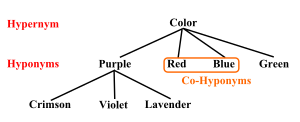Hyponymy and hypernymy
In linguistics, a hyponym is a word that can be changed with a different and less precise word without changing the overall meaning of the phrase. The different word is its hyperonym, hypernym or superordinate term.[1][2][3] Hyponymy is a relation to a more generic word.[4] A hyponym can be part of a group of words on a similar level that can all be replaced by the same hypernym. For example, pigeon, crow, eagle and seagull are all hyponyms (co-hyponyms) of bird (their hypernym). In turn, bird is a hyponym of animal.[5] In a sentence such as 'The pigeon is flying over the church.', it is possible to change the word pigeon to bird or animal without changing the overall meaning of the sentence. This is because pigeon is a hyponym of both bird and animal.

A hypernym is sometimes also called an umbrella term or a blanket term. [6][7][8][9]
The word Hyponym comes from the Greek hupó, "under" and ónoma, "name". Hypernym comes from the Greek hupér, "over" and ónoma, "name". A hyponym can also sometimes be a phrase. A word can be both a hypernym and a hyponym.
Usage
changeIn Computer science this relationship is often called an "is-a" relationship. For example, the phrase 'Red is-a colour' describes the hyponymic relationship between red and colour.
The idea of hyponymy is very important in language translation. This is because hyponyms are very common across languages. For example, in Japanese the word for 'older brother' is ani (兄), and the word for 'younger brother' is otōto (弟). An English-to-Japanese translator needs to choose which Japanese word to use to translate the English word brother. This can be difficult during machine translation because this information is often not available.
Related pages
changeReferences
change- ↑ Brinton, Laurel J. (2000). The Structure of Modern English: A Linguistic Introduction (Illustrated ed.). John Benjamins Publishing Company. p. 112. ISBN 978-90-272-2567-2.
- ↑ Stede, Manfred (June 2000). "The hyperonym problem revisited" (PDF). The hyperonym problem revisited: Conceptual and lexical hierarchies in language generation - W00-1413. Vol. 14. Association for Computational Linguistics. pp. 93–99. doi:10.3115/1118253.1118267. ISBN 978-9659029600. S2CID 477974. Retrieved 5 January 2014.
- ↑ Brinton, Laurel J. (2000). The Structure of Modern English: A Linguistic Introduction. John Benjamins Publishing. ISBN 9781556196621.
- ↑ Brinton, Laurel J. (2000). The Structure of Modern English: A Linguistic Introduction. John Benjamins Publishing. p. 135. ISBN 9781556196621.
- ↑ Fromkin, Victoria; Robert, Rodman (1998). Introduction to Language (6th ed.). Fort Worth: Harcourt Brace College Publishers. ISBN 978-0-03-018682-0.[page needed]
- ↑ "Umbrella Term Law and Legal Definition". uslegal.com. Retrieved December 11, 2018.
Umbrella term is also called a hypernym
- ↑ Alexander Dhoest (2016). LGBTQs, Media and Culture in Europe. Taylor & Francis. p. 165. ISBN 9781317233138. Retrieved December 11, 2018.
Hypernym can also be called an 'Umbrella term'
- ↑ Robert J. Sternberg (2011). Handbook of Intellectual Styles. Springer Publishing Company. p. 73. ISBN 9780826106681. Retrieved December 11, 2018.
umbrella term, or hypernym
- ↑ Frank W. D. Röder (2011). The Roeder Protocol. Books on Demand. p. 77. ISBN 9783842351288. Retrieved December 11, 2018.
Synaptic plasticity is a hypernym (umbrella term)
Sources
change- Snow, Rion; Daniel Jurafsky; Andrew Y. Ng (2004). "Learning syntactic patterns for automatic hypernym discovery" (PDF). Advances in Neural Information Processing Systems. 17.
- Hearst, M. (1992). "Automatic acquisition of hyponyms from large text corpora". Proceedings of the 14th conference on Computational linguistics -. Vol. 2. p. 539. doi:10.3115/992133.992154. S2CID 15763200.
{{cite book}}:|journal=ignored (help)
Other websites
change- Hypernym at Everything2.com